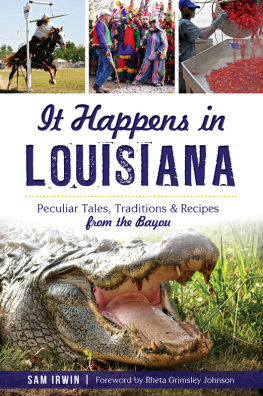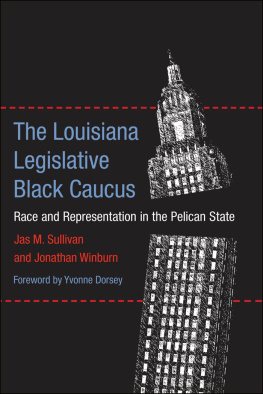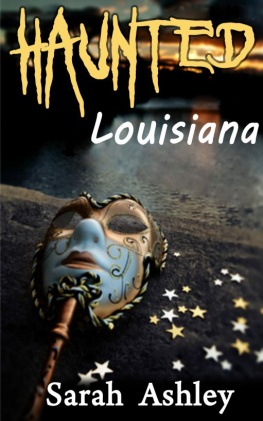P is for Pelican
A Louisiana Alphabet

Written by Anita C. Prieto and Illustrated by Laura Knorr

For Scott, Tony, Jean, David, Taylor, Adam, Amanda, Casey, and Logan
who can recite the alphabet. And for Abigail, who is just learning it.
ANITA
My deepest gratitude and thanks for their patience and support to Jennifer,
Barb, Heather, and the wonderful staff of Sleeping Bear Press. Youre the best!
LAURA
A
The alligator is the official reptile of the state of Louisiana. The word alligator comes from the Spanish el lagarto, meaning the lizard. In the wild, alligators play an important part in wetland communities by helping to control overpopulation by wild animals.
Louisianas alligators were almost extinct by early 1960. They were hunted for their skins, which were made into boots, shoes, wallets, purses, luggage, and belts. Then they were made an endangered species and given full protection from hunters. By 1987, the alligator population was stable.
A is for Alligator
The Alligator crawls on a swampy trail.
He has sharp, pointy teeth and a long, long tail.

B
Beignets (pronounced benyea) are square doughnuts without a hole in the middle. They are sold in French Market coffee shops in New Orleans, Louisianas largest city. Acadian French settlers made these delicious pastries as long ago as the time of the Civil War.
Beignets are served warm with lots of powdered sugar sprinkled on top. Its fun to watch them being made right before your eyes. Grownups like to dunk them in caf au lait (coffee and milk), but children like them best with a glass of cold milk. Be careful when you eat them, though, or you will end up with powdered sugar all over your face!
As you enjoy your beignets sitting in an outdoor cafe, you will see the St. Louis Cathedral in the distance. People ride by in colorful horse-drawn carriages. The Mississippi River is nearby. You might hear the music of a calliope on a paddle-wheel excursion boat.
B is for Beignet
Sugarcoated doughnuts served piping hot and sweet.
Children love to eat Beignets.
What a yummy treat!

C
Crawfish look like tiny lobsters. But while lobsters live in the sea, crawfish live in freshwater ditches or ponds. Crawfish are three to four inches long. They have four pairs of jointed legs, which help them walk along the bottom of their shallow-water homes. When frightened, they swim backward. Have you heard the expression, Dont crawfish out of that? It means dont back out of something you have agreed to do.
Crawfish also have two powerful claws (pincers)their chief weapons of defense. They can move their eyes in any direction. Two long feelers explore surrounding waters.
The crawfish is the official state crustacean. Some people in Louisiana call crawfish crawdads. Outside of Louisiana, crawfish is usually spelled crayfish.
C is for Crawfish
If you walk in muddy waters where the Crawfish grow, be very, very careful or theyll pinch you on the toe!

D
Much of Louisiana was once part of an ancient inlet of the Gulf of Mexico. As the Mississippi River flowed through the area, it carried large amounts of silt (small bits of earth) into the inlet. Over thousands of years, the land was built up. Even today, as the Mississippi continues to deposit sediment, new land is being formed in south Louisiana.
The delta is the new land being formed at the mouth of a riverland that usually takes the shape of the Greek symbol delta. This is what is happening south of New Orleans where the Mississippi forks into several directions as it empties into the Gulf of Mexico.
Sometimes this new land is called a birds foot delta because it looks like the triangular shape of a birds foot.
The overflow of the Mississippi River has made Louisianas soil very fertile. Cotton, Louisiana yams, rice, tomatoes, strawberries, soybeans, corn, and sugarcane are some of the crops grown there.
D is for Delta
Delta land is fertile ground, the farmers think its tops.
Its a perfect place for growing a variety of crops.

E
The snowy egret is a long-necked migrant bird with beautiful white plumage. It is one of many varieties of birds that visit the rich marshes of south Louisiana. But in the early years of the twentieth century, egrets were killed for their feathers. Soon very few birds returned to feed each year.
Thats when Mr. Edward Avery McIlhenny decided to turn Avery Island into a sanctuary for egrets and all manner of birds (pelicans, spoonbills, herons, blue-winged teal, mallard, shiny black ibis). Mr. McIlhenny stocked ponds with food and brought in wagonloads of twigs and branches, which the birds used to build nests. He called his project Bird City. Gradually, more and more birds returned to the safety of the sanctuary.
E is for Egret
Snowy white Egrets, what a beautiful sight, as they rise from the water and soar off in flight.

F
A fais do-do is a country dance. Young and old meet to enjoy delicious Cajun food, sing songs, and dance to lively music played by a fiddler. In French, fais do-do means go to sleep. Cajun mothers put their babies to sleep with a French lullaby. Then they join their friends at the dance.
The Acadians (or Cajuns) were a group of French people who left their homeland in the 1600s and settled in Canada. They called their new home Acadia. Later, that name was changed to Nova Scotia. When the British took over in Acadia, the Cajuns were driven from their homes.
They settled in many places in America. A large group came to southwestern Louisiana where, even today, they honor their French language and customs.
F is for Fais do-do
At a Fais do-do youll tap your feet and dance to the tune of a fiddlers beat.

G
Louisiana is a Gulf Coast state. The Gulf of Mexico plays an important role in Louisiana life. People come from all over to fish in the gulf waters, catching blue marlin, amberjack, tarpon, red snapper, king mackerel, wahoo, and many other fish. Commercial fishermen harvest oysters and trawl for shrimp offshore.













